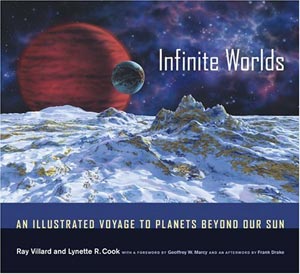|
|
Review: Infinite Worlds
by Jeff Foust
Monday, February 13, 2006
Infinite Worlds: An Illustrated Voyage to Planets Beyond Our Solar System
by Ray Villard and Lynette R. Cook
University of California Press, 2005
hardcover, 272 pp., illus.
ISBN 0-520-23710-2
US$39.95
In a field of science so well known for its stunning visualizations, extrasolar planets present a major challenge. The general public has come to expect gorgeous pictures from astronomers and planetary scientists, be they images of distant galaxies by ground- or space-based telescopes, or close-up photos of nearby planets taken by spacecraft. Extrasolar planets, however, cannot be seen even as faint points of light: most have been discovered by detecting the periodic Doppler shifts in the spectral lines of their parent stars caused by the gravitational tug of an orbiting planet, or else by observing a brief, faint diminution of that star’s light as the planet passes in front of the star as seen from Earth. Neither lightcurves nor spectra, though, make for compelling images, other than perhaps for professional astronomers. To help better communicate their results to the public, some astronomers have turned to space artists to offer speculative portrayals of what these worlds might be like. One such artist has joined forces with a science communicator to both describe these worlds and put them into a broader context.
Infinite Worlds is not just about the nearly 200 extrasolar planets that have been discovered to date. Rather, writer Ray Villard and artist Lynette Cook start at the beginning—literally—with the Big Bang, the formation of galaxies, stars, and solar systems, specifically our own. Then, nearly halfway into the book, they turn their attention to planets outside our solar system and how they were discovered, as well as speculation on the types of planets that might exist (such as planets floating free in interstellar space, having been ejected from the solar systems of their birth via gravitational interactions with stars and other planets.) The book then turns towards the prospects for life, intelligent and otherwise, on those worlds, and how we might look for it with telescopes or, someday, interstellar probes.
| Infinite Worlds uses images and illustrations to enhance the text’s description of the search for extrasolar planets and life, rather than treating the text as filler between pages of pictures. |
While Infinite Worlds has the oversized appearance and rich color illustrations associated with a typical astronomy coffee table book, this book manages to successfully avoid the trap many similar books fall into, where the pictures relegate the text to second-class status. Infinite Worlds uses images and illustrations to enhance the text’s description of the search for extrasolar planets and life, rather than treating the text as filler between pages of pictures. The text is oriented towards the educated layman, and as such those who already know a fair amount about the subject won’t learn that much from reading the book. However, most everyone will appreciate the illustrations of potential extrasolar worlds featured in the book.
One criticism of such illustrations of extrasolar planets is that they give the viewer the impression that we know far more about these worlds than is actually the case. Spectra and lightcurves of Sunlike stars allow astronomers to know the first-order characteristics of extrasolar planets—orbit and mass—but offer no insights into whether these planets have rings or moons, as often depicted in such illustrations. That’s a valid criticism, and scientists and artists alike are careful to note that these illustrations show what such worlds might look like, not their actual appearance, although such disclaimers may be lost on the general public. (Of course, many of the actual images of planets and galaxies taken by telescopes and spacecraft have been heavily manipulated to enhance their appearance.) Given that it will most likely be several decades before the first low-resolution images of Earthlike extrasolar planets will be taken, illustrations like those featured in Infinite Worlds offers at least a preview of what might be in store for future generations of astronomers.
Jeff Foust (jeff@thespacereview.com) is the editor and publisher of The Space Review. He also operates the Spacetoday.net web site and the Space Politics weblog. Views and opinions expressed in this article are those of the author alone, and do not represent the official positions of any organization or company, including the Futron Corporation, the author’s employer.
|
|
